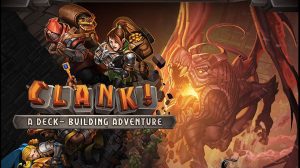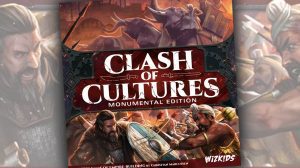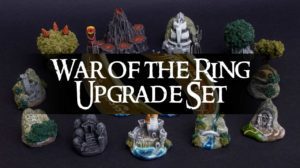Imagine a distant planet set in a futuristic sci-fi universe. Three separate factions have come to the planet in search of its valuable crystals, while a fourth faction attempts to defend its homeworld from these distant invaders. Through combat and strategic maneuvering each player attempts to gain control of crystal-rich regions, which will ultimately score them the points needed to emerge victorious.
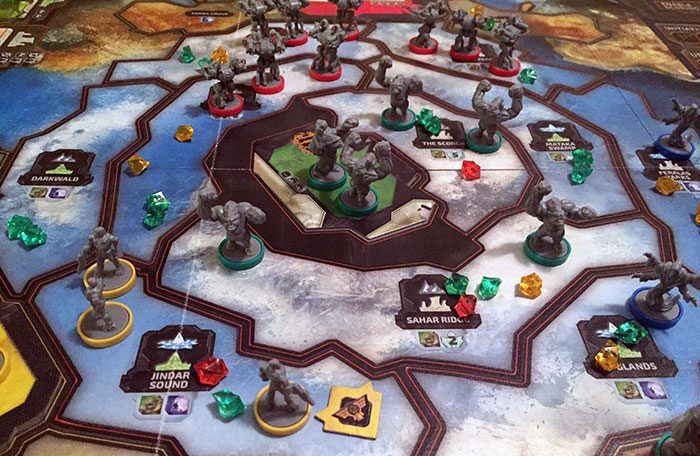
Cry Havoc Overview
Cry Havoc is a card-driven area control game with four asymmetric factions. Machines, Humans, Pilgrims, and the native Trogs. Each faction has a different set of abilities, units, and buildable structures, and as such a different play-style/strategy. The Machines’ goal is to kill everything in sight, the Humans aim to quickly spread out across the map to gain control, the Pilgrims mostly try to avoid combat and mine for resources, while the Trogs simply want to defend their homeland from foreign invaders.
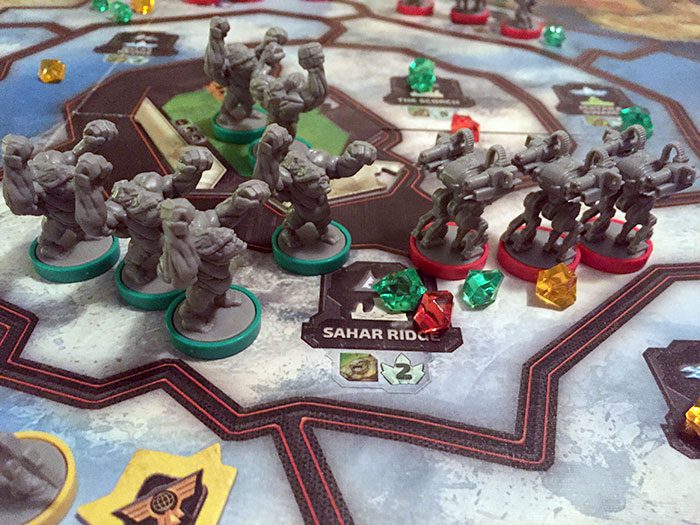
How to Play Cry Havoc
The basic gameplay revolves around a player’s unique deck of action cards. Each card displays multiple symbols representing the different types of actions they can perform (move units, build structures, recruit new units). On your turn you can play as many cards as you like, but may only choose one of the actions. For instance, if you wanted to recruit 5 new units, you could play multiple cards with the “recruit” icon on them, ignoring any other symbols. Any cards used are then discarded. Some cards also have abilities that can be used in combat.
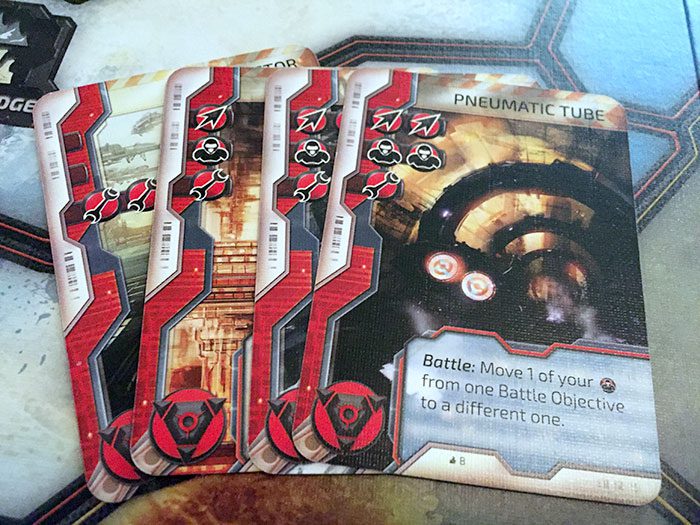
There never seems to be enough cards in order for you to do everything you want to do, but therein lies the challenge. Do I spend these cards to move my units? Should I build new structures that will give me special powers? Or should I save these cards to be used to alter combat? These are the type of difficult decisions that permeate this strategic game, making it equally frustrating and exhilarating, depending on the choices you and the other players make.
The game has a maximum of five rounds. Each round starts with a randomly selected event token which affects every player. These events can be helpful: for example an event allowing everyone to add a figure or some crystals to the board. Some events are less than helpful, perhaps forcing everyone to destroy one of their units. The last round’s event will always be “Enable Final Scoring.”
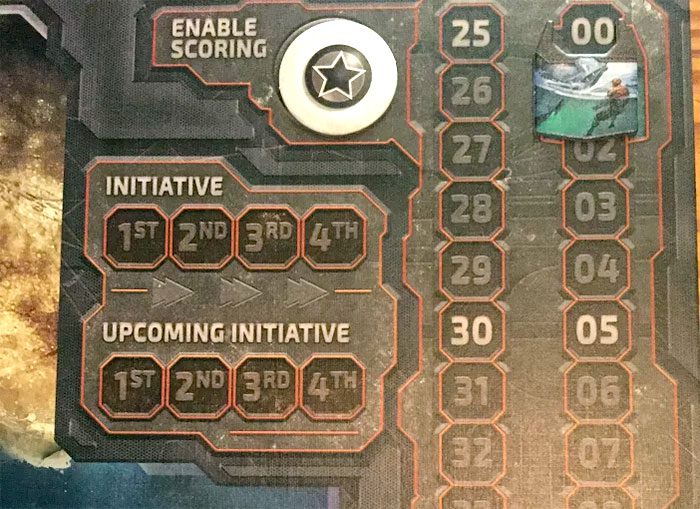
Actions:
During the course of the round, each player will take turns performing one action. After each person has performed three actions, each combat is resolved, and scoring, if enabled, takes place. Let’s take a closer look at the actions that a player can select on their turn.
Move Units
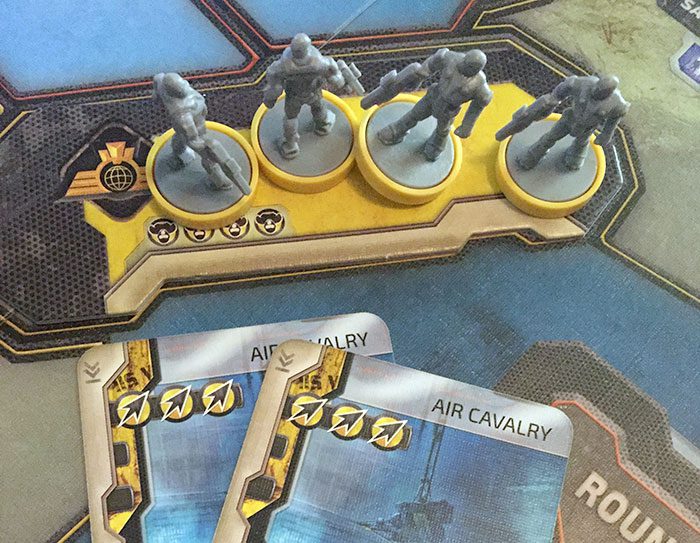
In order to perform the move action, a player must discard a card or cards containing the move symbol. The player will then get a number of movement points equal to the number of move symbols on the cards they played. It costs one movement point to move one figure one space. Movement points can be divvied up any way you see fit. For example, with 2 movement points you can either move one figure two spaces, or move two figures one space.
Recruit New Troops
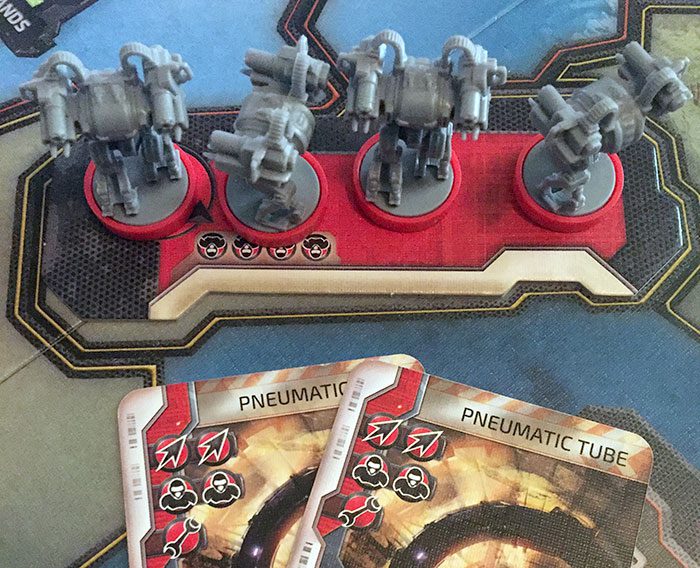
Similar to the move action, a player discards any number of cards from their hand containing the recruit symbol and gets to add that many figures from their reserve onto the board. These will go directly to their HQ.
Build/Activate Structures
Each player has unique structures that provide a unique special ability when activated. To use the build/activate action, discard any number of cards with the build symbol to gain that many building points. Building points can be used to build and/or activate structures. The cost for building and activation is printed on the structure tile. For example, if the Machines player discarded cards containing three build symbols, they could build an Orbital Sniper, then activate it, using the ability listed.
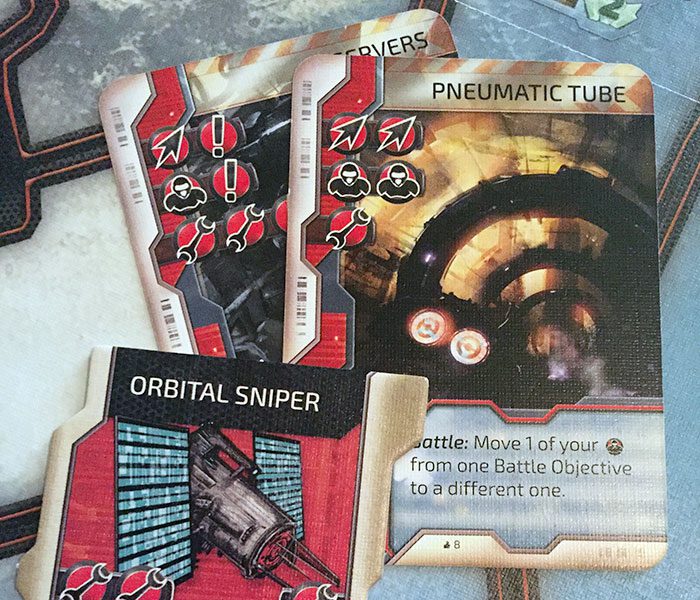
Structures must be built in areas you control. You can never build two of the same building in the same region, nor can you activate the same building more than once in the same turn.
Draw Cards
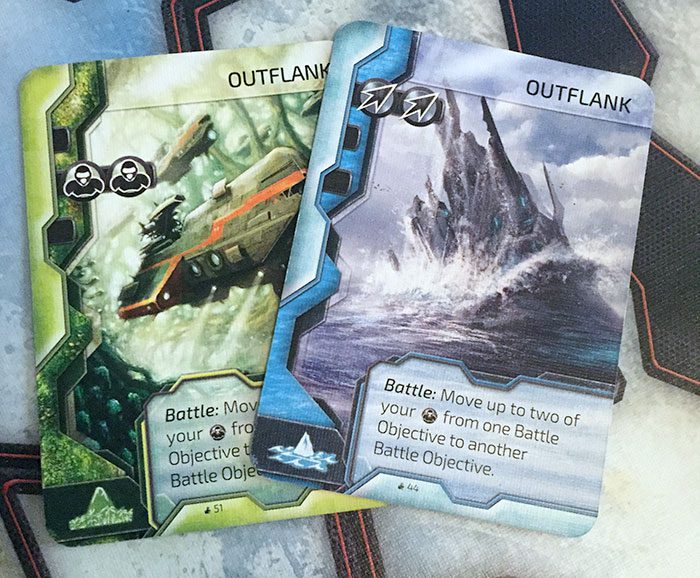
Since you discard your cards in order to perform actions, you will inevitably run low on cards. With the Draw Cards action, you can draw two cards and then keep one. You may choose to either draw from your own personal deck or from the four “Terrain Tactic” decks. Each set of terrain tactic cards specializes in a specific action in addition to their special battle abilities. Each region of the board has up to two different types of terrain. (Mountain, desert, jungle, or ocean) When you battle in a region, you can only use terrain tactic cards that match its terrain. The terrain cards can also be discarded for actions, just like cards in your main deck, as they also have the action symbols discussed earlier.
Enable Scoring
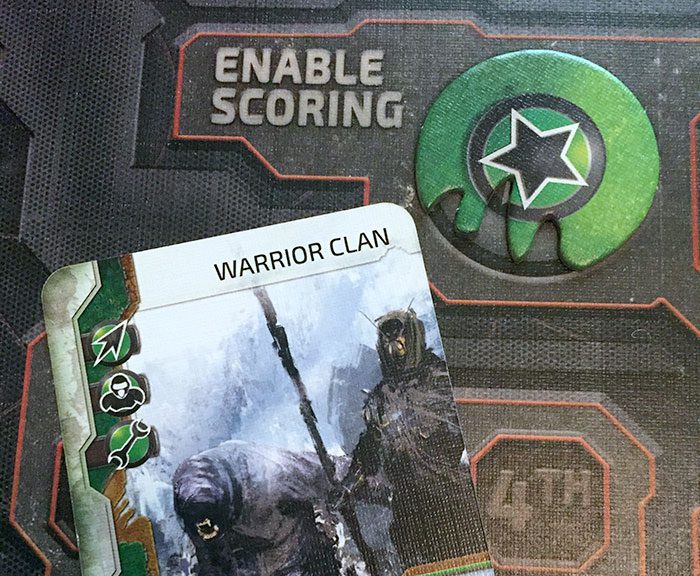
The final action is to enable scoring. There is one card in each player’s deck that can trigger this action. To enable scoring, you simply discard that card, ignoring any other symbols on it, and place your scoring token on the indicated spot. This counts as your entire action. Enabling scoring is significant because no one scores any points for region control at the end of the round if it has not been enabled. Only one player can take this action per round. When scoring, players get VP for each crystal located in a region they control, and the player who enabled the scoring will also get a bonus VP for each territory they control.
The World of Cry Havoc:
Exploring the planet by moving your troops around the board is not without its risks. You may encounter Trog War Parties, which instantly spawn additional Trog forces and crystals. You may also find helpful exploration tokens, which can give you more crystals, figures, or tactic cards.
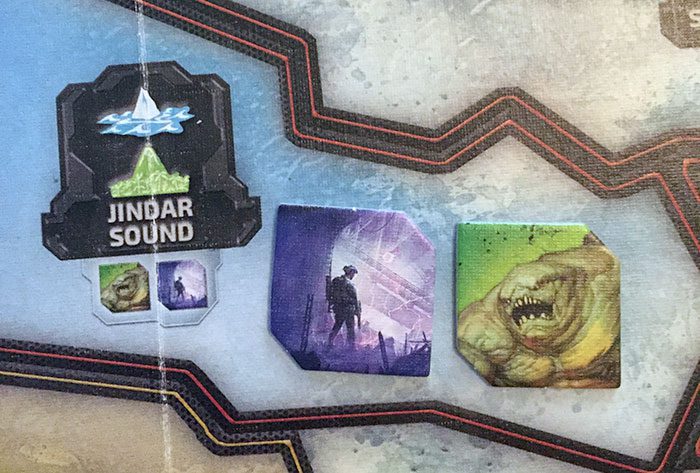
Watch out, though. If you enter a region that contains an enemy unit, a battle will happen. Since all of the battles are resolved at the end of the round, you place a battle token into the region to show that it is an embattled region. Once a region is embattled, figures can no longer move into it and structures in the region cannot be activated. It’s basically on lockdown until the combat is resolved. Because battle regions get locked down, deciding when and where to engage enemy forces can make or break your strategy.
How to Win
Victory points can be gained by winning battles, taking prisoners, and destroying enemy figures. Players will score points each round, if scoring has been enabled, for crystals located in regions that they control. The player that enabled scoring will also get a bonus point for each region they control. At the end of the last round, one final scoring takes place. The player with the most points is declared the winner. In the case of a tie, the player who took the most prisoners wins.
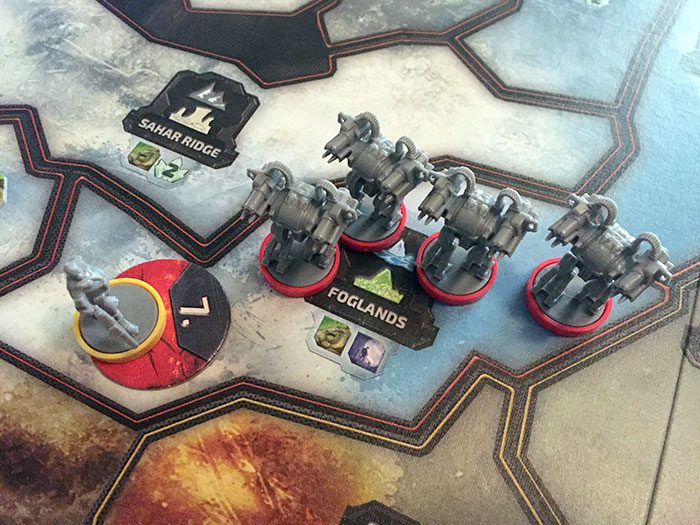
What I Like About the Game:
Asymmetry

The factions truly are asymmetric: each one has a unique deck of cards, unique buildings, and unique special abilities. I have played all of the factions and I can attest that each one plays differently. Additionally, the terrain cards that players can draw allow for a little bit of deck-building. You can add these cards your deck to maximize your existing strengths or make up for your inherent deficiencies.
Combat

The combat system is unique and streamlined. Instead of rolling dice or a having a complicated matrix of hits vs defense, the game simply uses a combat board. On the board are three objectives: region control, capture prisoners, and attrition. The attacking player places their battling figures on one or more of these objectives. The defender then places their figures, and each in turn has a chance to play battle cards to affect the combat. This battle system makes every decision important. Do I want to win control of the region and score 2 VP? Do I want to capture one of the opponent’s figures, to both score VP each round and keep them from accessing it? Or do I simply want to destroy my enemy’s units, scoring a VP per kill?
Decisions, Decisions

This game is all about hard choices. When do I move my troops? What should I build? How many cards should I devote to this action? What cards should I save to use in combat? Which objective do I focus on in combat? Which cards should I play in combat? All of these questions keep me scratching my head. I’m mentally engaged from the opening move to the final tally.
What I Didn’t Like About the Game
The Rulebook
Although the rulebook lays out the basic actions and turn structure well enough, as well as providing some combat examples, the rule book doesn’t address any of the faction-specific special powers. This can lead to confusion on how a player’s buildings and special powers work, in addition to how they interact with each other. This rulebook could definitely use an appendix which lists and summarizes all the player powers, as well as an FAQ section for commonly mistaken rules.
Balance

Although I have not played every faction multiple times, the four factions seem to be slightly imbalanced. This is potentially a big problem because not everyone will want to play through a two-hour game multiple times, just to figure out how their faction can win. Additionally, there isn’t any sort of ‘catch-up’ mechanic that would prevent a runaway leader. This can be discouraging for new players if they fall behind, potentially turning them off from future plays.
Final Thoughts

Cry Havoc is an excellent game full of difficult decisions, strategic placement, and interesting combat. It has a ton of variability and replayability. I can’t see it ever leaving my collection, mostly because I want to play each faction enough times to find out how they tick. I enjoy how the relatively simple options allow for incredibly difficult choices. I like the tactical card-play and the ingenious streamlined battle system. It also doesn’t overstay its welcome, clocking in at an average of just two hours (relatively short for a game of this scale).
While it may have some quirks and kinks to be ironed out, it remains a fantastic game that is a sure contender for my Top 6 Games of 2016. If you are a fan of tactical gameplay and strategic area-control, I highly recommend Cry Havoc.
What do you think about Cry Havoc? Give us your opinions about what you like and/or dislike about the game in the comments below!




